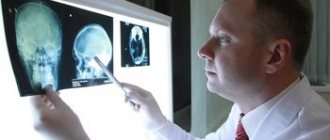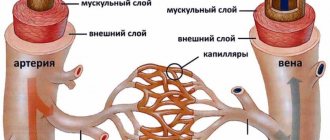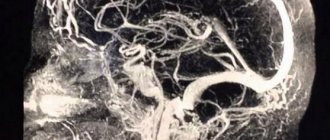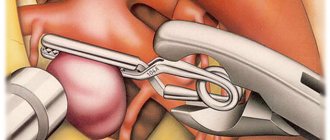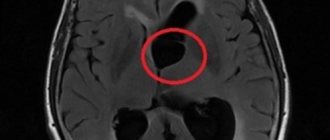Leukoaraiosis is diagnosed when the white matter of the brain is affected. Additionally, changes are observed due to chronic ischemia and disruptions in blood flow. The disease is rare.
The pathology does not develop against the background of disturbances in blood circulation. The lesions may be located deep in the hemispheres or evenly surround them. The condition is dangerous and poses a real threat to the patient’s life. Changes in the functioning of the central nervous system cannot be reversed.
Where are the origins of the disease?
Research has confirmed the scientists' assumption that the disease develops due to circulatory problems. As a result, the cells do not receive sufficient nutrition. The pathology is often diagnosed in people who suffer from ischemia, vascular dementia or other vascular diseases of the brain.
Leukoaraiosis can be a consequence of a stroke. The pathology is often found in people with Alzheimer's disease, accompanied by atrophy and age-related changes. As a result, the person is diagnosed with dementia.
Doctors also consider Binswanger's disease a possible cause. It is characterized by the presence of an unusual form of discirculatory encephalopathy.
As a result of atrophy of nerve tissue, the functioning of the central nervous system is disrupted. Drastic changes are also observed in the composition and structure of the white matter of the brain. The risk of developing leukemia increases if a person has diabetes mellitus or abnormal metabolic processes.
Scientists have been able to identify factors that increase the risk of developing pathology:
- chronic excessive alcohol consumption;
- smoking;
- poor diet and inactive lifestyle;
- elderly people.
To understand the processes that occur in the brain:
Prevention
Due to the lack of specific treatment for leukoaraiosis, preventive measures can be used to reduce the risk of developing this disease:
- Balanced diet.
- Frequent walks in the fresh air.
- Active lifestyle.
- Avoiding the use of alcohol, tobacco and drugs.
- Avoid stressful situations.
- Timely detection and treatment of diseases that contribute to the development of leukoaraiosis.
Leukoaraiosis of the brain is an insidious disease. Neglect of preventive measures can lead to disability and even death.
What is periventricular leukoaraiosis
Periventricular leukoaraiosis is diagnosed if a decrease in the density of white matter is detected. The disease most often spreads along the lateral ventricles of the brain or evenly over the entire surface in the form of small foci. As a result, the nervous system around the front horns has the appearance of ears or a cap. This is clearly visible on the MRI results.
With leukoaraiosis, partial loss of neurons and their processes is observed. The situation is typical for the entire affected area. Over time, the myelin sheaths, which are necessary for the timely transmission of nerve impulses, disintegrate. The fibers of the white matter are also destroyed. As a result, the brain lacks the pathways used to transmit impulses.
In some cases, the situation is aggravated by swelling of the nervous tissue. Small cysts begin to form around the vessels. All processes associated with diffusion take place in the lesions. Therefore, lacunar strokes are periodically observed. In this case, tissue necrosis is not limited. The result of the reactions is spongiosis. As a result, the fabric becomes like a rubber sponge with a porous structure.
Lacunar infarction and leukoaraiosis often occur together
Will an MRI of the brain show leukoaraiosis?
Magnetic resonance imaging is considered one of the most informative ways to study cerebral structures. As a result of MRI, layer-by-layer images are obtained with a step of 1 mm.
The scan is carried out in three mutually perpendicular projections; if necessary, the doctor reconstructs a 3D model of the area in question. Tomograms visualize the structure, shape, and dimensions of intracranial structures. Three-dimensional projection helps to assess the localization and extent of the pathological process.
Changes characteristic of leukoaraiosis are clearly visible on MRI of the brain. The method allows you to assess the state of the white matter and shows a violation of the integrity of the myelin layer of neurons. To visualize the circulatory system, MR angiography is prescribed.
The study of cerebral vessels is carried out using a contrast agent. After intravenous injection, the solution fills the bloodstream and intercellular space. Tomograms make it possible to assess the lumen, fullness, and condition of the walls of blood vessels. As a result of angiography, pathologies of cerebral veins and arteries, the consequences of cerebral circulatory disorders (ischemia, etc.) are revealed.
Scanning is used for differential diagnosis of degenerative-dystrophic, inflammatory, demyelinating processes, which may result in destruction of white matter. MRI shows structural changes in brain tissue, helping to identify affected lesions with a diameter of 3 mm.
Magnetic resonance imaging allows you to identify leukoaraiosis at the initial stage, clarify the pathogenesis of the disease and choose an effective treatment method. The effectiveness of therapeutic and surgical measures largely depends on the etiology of the destructive process.
Stages of development
Leukoaraiosis of the head, as a disease, goes through three stages of development:
- With stage 1
of the disease, a medical examination can reveal revitalization of tendon reflexes, human instability, a reduction in step length when walking, and the ability to move only slowly. Neuropsychological examination reveals suppression of cognitive changes. The person complains of poor attention and memory deterioration, and cognitive activity is significantly reduced. - At stage 2,
the presence of clinical syndromes is clearly visible. The patient notices memory deterioration, and at the same time mental and psychomotor reactions slow down. A person cannot control his actions and notices uncertainty in his own walking. In some cases, the presence of apathy, depression, irritability and lethargy is noted. There is deterioration in the functioning of the genitourinary system - uncontrolled urination at night. A person loses social adaptation, which manifests itself in the form of deterioration in performance and the inability to care for oneself independently. - At stage 3
, the clinical picture worsens and leads the patient to disability. Behavioral disorders are clearly noticeable (severe lethargy, inability to walk independently, which sometimes ends in a fall, chronic urinary incontinence). At this stage, doctors note pronounced signs of a disorder in the functioning of the cerebellum.
Degrees of leukoaraiosis at a young age
The formation of pathological foci and ischemic segments near the ventricles has different severity.
Classification of leukoaraiosis by morphology:
- 1st degree – slight loss of coordination, decreased walking speed;
- 2nd degree – development of clinical symptoms of movement disorders, loss of concentration and memory;
- Grade 3 is accompanied by a significant expansion of the ventricular spaces, increasing the manifestations of the disease. Patients require outside supervision;
- Grade 4 is characterized by uncontrolled urination, loss of balance, and suppression of psychomotor activity.
The progression of the pathology takes several years. Morphological changes are irreversible, so it is better to verify first-degree brain disorders, when supportive treatment can be selected.
The child has no clinical symptoms. Diagnosis is carried out due to the impossibility of treating speech disorders.
First signs and development of symptoms
At the first stage of the development of the disease, it is difficult to identify the exact symptoms. Sometimes the clinical picture goes unnoticed. Most often they are paid attention to as they progress:
- disturbances in a person’s emotional state, which manifests itself in the form of constant depression and discomfort in society;
- memory deteriorates sharply, disturbances in the ability to think clearly are observed;
- changes in speech functions;
- disturbance of movement and functioning of the musculoskeletal system.
The further course of the disease can also occur without obvious symptoms until the moment of exacerbation or with a gradual deterioration of the condition. You can consider the most characteristic signs of leukoaraiosis:
- change in a person’s speech capabilities for the worse;
- frequent mood swings, which are accompanied by depression and chronic dystrophy;
- obvious disturbances in the functioning of the musculoskeletal system;
- deterioration of basic memory properties;
- a noticeable change in intellectual and thinking abilities.
Establishing diagnosis
If a patient is suspected of having structural changes in the white matter, he is referred for angiography. The X-ray technique evaluates the condition of blood vessels and the functioning of the central nervous system. If pathology is suspected, additional examinations are prescribed.
To diagnose the disease, a magnetic resonance imaging or computed tomography machine is used. The device shows manifestations in mild and moderate form.
Thanks to modern equipment, the doctor can also determine the presence of a severe clinical picture in the patient.
Goals and methods of therapy
The main goal of treatment is to reduce the manifestation of symptoms that are a consequence of disruption of the human brain.
The doctor prescribes medications to the patient whose action is aimed at optimizing metabolic processes and improving blood flow to the brain. Medicines reduce spasms and improve blood circulation and cell nutrition.
For this purpose, one of the following drugs is selected: Piracetam, Oxiracetam, Nitroglycerin, Aspirin, Nimodipine, Cinnarizine, Eufillin.
Self-medication for such a serious illness is not worthwhile. Only a specialist in this matter will be able to correctly calculate the dose and choose the right drug. For this purpose, you should visit the office of a neurologist, who should additionally pay attention to all associated pathologies.
Today, there are methods for treating the disease without the use of medications.
Moderate physical activity promotes rapid recovery. To choose the right load, you should consult with a physical therapy doctor and perform therapeutic exercises yourself at home. Swimming has a positive effect on the body, so the patient is recommended to visit the pool regularly.
Therapeutic massage is used to further strengthen muscle tone. Only a qualified and experienced specialist will be able to correctly navigate the required complex and apply it correctly. To obtain the best result, it is advisable to use all methods in combination.
The patient is advised to completely stop drinking alcohol and smoking. He should eat a balanced diet and exclude fatty foods from the diet. Particular attention should be paid to the consumption of vegetables and fruits, fish. If a person loves meat, then the choice should be a low-fat variety.
A favorable outcome can be expected only if the pathology is detected in a timely manner. With the help of a properly selected integrated approach to therapy, it is possible to significantly slow down the progression of the disease. Therapeutic methods are used not only to eliminate pathology, but also to improve the flow of blood to the brain.
Treatment
Today there is no specific drug treatment for cerebral leukoaraiosis, since the causes of its occurrence are not fully understood.
The main method of treating leukoaraiosis is drug therapy aimed at treating the underlying disease. The course of treatment is prescribed by the attending physician. These are drugs with vasoactive properties - improving blood circulation. These drugs include: Eufillin, Vinpocetine or Pentoxifylline, Cinnarizine. The complex uses drugs that block calcium channels - Flunarizine.
Nootropil with the active ingredient piracetam has proven itself well. Piracetam is a nootropic drug that improves brain functionality.
Preventive measures
To date, there is no vaccine or medicine that could protect against the development of leukoaraiosis in the future. For preventive purposes, doctors may advise leading a healthy lifestyle.
A person should live in a mode of moderate activity and monitor nutrition. It is important to give up bad habits, because they have a detrimental effect on the functioning of the central nervous system.
If there is a cerebrovascular disease, the patient should receive timely treatment. Older people should have their functioning assessed regularly.
Diagnostics
A neurologist will tell you how terrible this diagnosis of leukoaraiosis is. The main methods of instrumental research include:
- Blood analysis.
- Angiography. Study of the condition of arteries, veins, vessels of the circulatory system.
- MRI, CT examination. Visualization of all departments, parts, elements of the brain.
In case of leukoaraiosis of the brain, MRI always shows the presence of vascular pathologies, which confirms the close connection of the disease with disruption of the blood flow system, which also determines treatment tactics.
